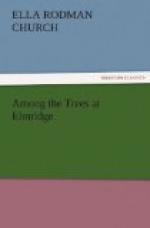“No,” replied his governess; “the name comes from the sweetness of the pulp around the seeds, which ripen in large flat pods, and of which boys and girls are fond. But the flowers of this species are only small greenish aments. Locust-wood is very durable, and, as it will bear exposure to all kinds of weather, it is much used in shipbuilding and as posts for gates. It is thought that the shittah and shittim wood of the Bible, of which Moses made the greater part of the tables, altars and planks of the tabernacle, was the same as the black acacia found in the deserts of Arabia and about Mount Sinai and the mountains which border on the Red Sea, and is so hard and solid as to be almost incorruptible.
“And now,” added Miss Harson, “reading of the numerous relations of the locust, considering that ’the acacia, not less valued for its airy foliage and elegant blossoms than for its hard and durable wood; the braziletto, logwood and rosewoods of commerce; the laburnum; the furze and the broom, both the pride of the otherwise dreary heaths of Europe; the bean, the pea, the vetch, the clover, the trefoil, the lucerne—all staple articles of culture by the farmer—are so many species of Leguminosae, and that the gums Arabic and Senegal, kino and various precious medicinal drugs, not to mention indigo, the most useful of all dyes, are products of other species,—it will be perceived that it would be difficult to point out an order with greater claims upon the attention.’”
CHAPTER XVI.
THE WALNUT FAMILY AND THE AILANTHUS.
“The walnut family,” said Miss Harson, “with the ugly name Juglandaceae, are distinguished by pinnate, or compound, leaves, which have an aromatic odor when crushed, and by blossoms in catkins. Of these trees, the black walnut is one of the handsomest and most highly prized.”
“Are there any of them here?” asked Malcolm.
[Illustration: THE WALNUT TREE.]
“No,” was the reply; “I do not think you have ever seen one. They are more common in the western part of the Middle States and in the Western States; in Ohio particularly they grow to a very large size. Solitary trees are sometimes seen in this part of the country, and the branches, extending themselves horizontally to a great distance, spread out into a spacious head, which gives them a very majestic appearance. The trunk is rough and furrowed, and the leaves have from six to ten pairs of leaflets and an odd one. They are smooth, strongly serrated and rather pointed; the color is a light, bright green. The catkins are green, from four to seven inches long, and hang from the axils of the last year’s leaves. The leaves are much longer than those of the locust, and the leaf-stalk is downy. The nut, which is very oily, is shaped like an English walnut, but resembles it in no other way, as the shell is very thick and dark-colored. When thoroughly dried, the black walnut is very much liked—as I think some witnesses here could testify—and is used in making candy.”




